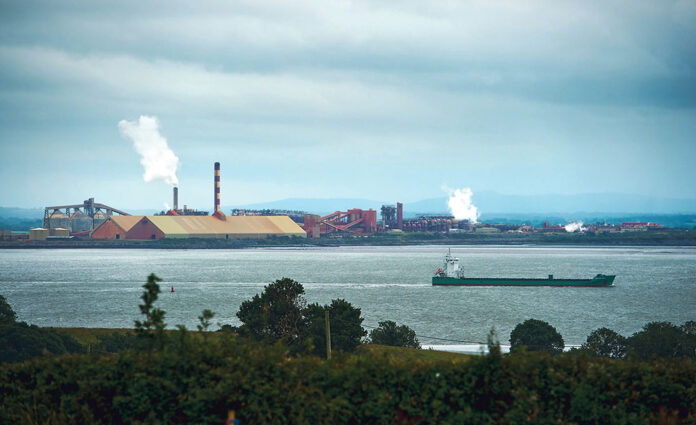THE government has never launched a “proper” investigation into the impact of the Rusal Aughinish alumina refinery on people and the environment, a local lobby group has claimed.
A four-agency investigation team, which carried out work in the late nineties, concluded that environmental pollution, toxic substances in the diet, soil composition anomalies and herbage composition are all “unlikely causes of animal health problems” on two farms in the Askeaton area.
The EPA-led investigation also stated an independent human health problem arising from atmospheric emissions in the area is “unlikely given that, since the mid-1980s, air quality measurements in the area have complied with EU standards”.
In a wide-ranging address in Limerick on Saturday, Emanuela Ferrari from Future Proof Clare, alleged the Environmental Protection Agency (EPA) keeps granting licenses to major industries, while the Oireachtas keeps “favouring corporate power over people’s wellbeing”.
She outlined the Rusal factory is the biggest alumina processing plant in Europe. Aluminium – and a lot of other minerals – are considered as a crucial component in the green transition towards zero emissions, according to the Government Climate action Plan, disregarding the huge environmental impact of its extraction and processing.
Ms Ferrari asked is gas considered as a clean source of energy, despite huge upstream Co2 emissions.
“We need scrutiny into the impacts of extractivism to sustain a relentless economic growth, and to question a course of action to solve the climate and biodiversity crisis that does not question the same economic and political system that puts us in this mess in the first place.
“Bauxite gets shipped in the Shannon estuary through huge, oil guzzling ships and gets turned into alumina in the Rusal factory through the Bayer process, an enormously energy intensive process that digests ore using very hot caustic soda.
“It relies on the burning of astounding amounts of natural gas. It is fuelled by 160MW heat and power plant onsite. The government climate action plan recognizes that the biggest share of enterprise emissions comes from a small number of large companies, and mentions alumina explicitly. Yet no clear intentions to tackle this are made clear, beyond devising an app for corporations.
“Instruments designed to measure industrial emissions are devised ad hoc for corporations to continue operating and destroying the environment. How could the Rusal factory be considered carbon neutral, otherwise, something it hopes to achieve in the near future?,” she asked.
She outlined the disposal of bauxite residue in red mud ponds is a huge environmental issue globally.
In the ‘90s, she recalled the state investigated emissions from industry, but they cleared the industry of any charges.
“Two huge open-air red mud ponds amounting to 450 acres in total contain 50 million tons of toxic waste which is stored just meters from the Shannon estuary. Red mud contains toxic heavy metals, and its high alkalinity makes it corrosive and damaging to soil and life forms. Yet red mud is classified as ‘non hazardous’ according to EU directives, falling instead in the more fuzzy and unregulated category of ‘toxic’.
“Now Rusal is looking for expansion and is seeking approval for an extension from 4.5 hectares to nine hectares of the red mud dump, and to build a borrow pit for rock blasting, which will go on for 20 years, four to five times a year.
“The lower River Shannon is also an area of special conservation and a bird sanctuary. It is one of the few breeding grounds of bottlenose dolphins in Europe, crucial to this form of life.”
The EPA recently ruled out plans for an oral hearing into proposals, which will lead to rock blasting at Aughinish.
Rusal Alumina has secured planning permission from An Bord Pleanala to build a borrow pit in Aughinish island to extract rock for use in the plant’s operations.
The plant was described as one of the most efficient facilities for alumina extraction in the world in an Environmental Impact Assessment Report (EIAR) submitted to the EPA in July 2017.
This report outlined the plant employs 450 jobs directly plus 185 maintenance and installation contractor employees, and considerable further employment for local service industries.
The plant sought planning permission for the provision of a borrow pit of 4.5 hectares to extract 374,000 m³ of rock over a ten-year period, with blasting up to seven times a year, and a restoration plan for the extracted area.
The report stated there will be no further impact experienced on the environmental sensitivities in the area over those experienced at the existing AAL plant.
A series of mitigation measures were outlined to reduce any potential impacts on receiving soils and geology on the site including groundwater monitoring and sampling of existing boreholes, no excavation below 8.5m OD, regular geotechnical assessments of face conditions and the presence of qualified health and safety person in conjunction with specially trained blasting
personnel will ensure compliance with relevant safety and statutory legislation,
including industry best practices and Aughinish’s own internal procedures.
“As rock has previously been removed from the borrow area, moderate adverse impacts have
occurred on the bedrock environment.
“As a result of the mitigation measures previously implemented and those proposed for the Application Site, it is considered that any impacts associated with proposed extraction related activities undertaken at the Application Site will not contribute to the cumulative impacts of any surrounding developments in the area,” the EIAR stated.
by Dan Danaher

